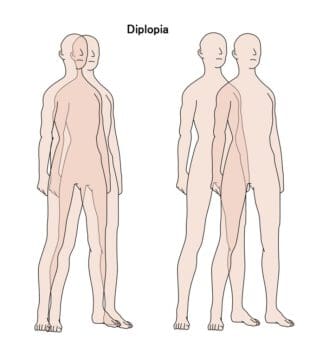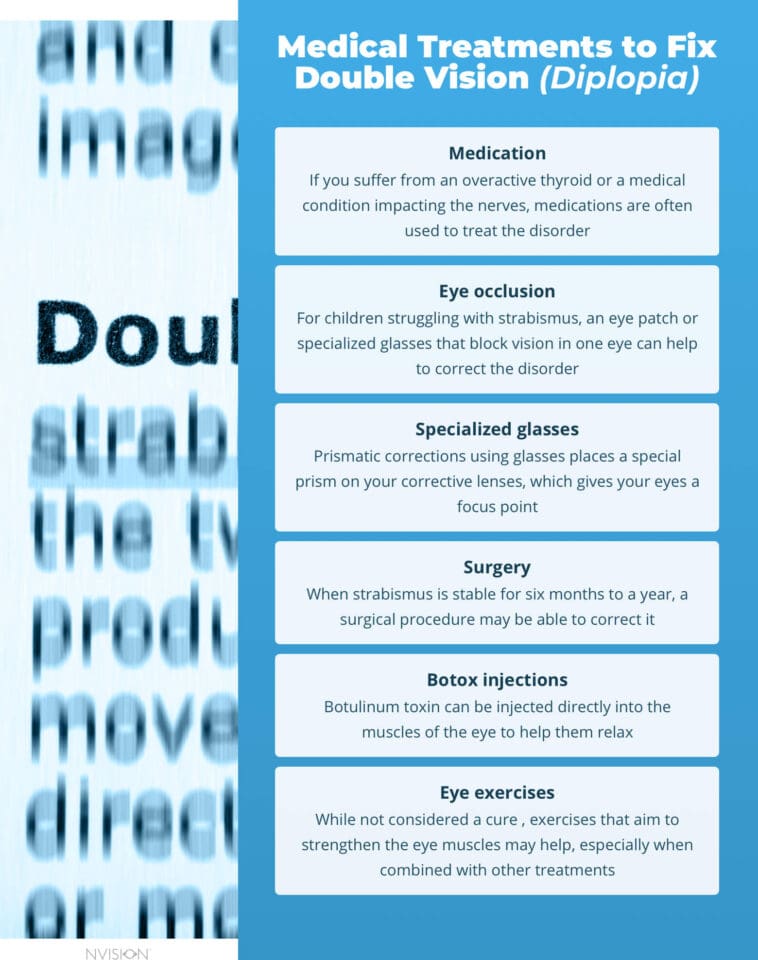Guide to Double Vision (Diplopia): Causes & Best Treatment Options
Home / Eye Conditions & Eye Diseases /
Last Updated:
Double vision is when you see more than one image when you should only see one.
Table of Contents
Sometimes the cause of double vision is temporary, like when you have too much to drink or suffer from a head injury. But diplopia is a condition in which double vision is not temporary. It can occur in either one eye (monocular) or both eyes (binocular).
Diplopia can be caused by a variety of factors, depending on the type. Monocular diplopia is often caused by irregularities in the eyes themselves, while binocular diplopia can signal a neurological disorder. Around 850,000 people seek emergency department (ED) care for double vision every year.
The only standard symptom of diplopia is double vision. In the case of binocular diplopia, diagnostic and neurological testing may need to be done to figure out what the underlying issue may be.
Treatment for double vision is dependent on the type and cause of the disorder. It can include wearing an eye patch, eye exercises, specialty glasses, or surgery. Diplopia can be managed and even potentially reversed with specialized treatment.
What Is Diplopia or Double Vision?

When you continuously see double, it may be related to a condition called diplopia.
There are two main forms of double vision, or diplopia. Monocular diplopia is when you see two images out of either eye with one of them closed. In the case of monocular diplopia, there is something blocking or changing the way that light is transmitted to the retina in the back of the eye. This form is rarer than binocular diplopia.
You deserve clear vision. We can help.
With 135+ locations and over 2.5 million procedures performed, our board-certified eye surgeons deliver results you can trust. Your journey to better vision starts here.
With binocular diplopia, you see double out of your eyes when both of them are open. The issue may disappear when you close one eye.
Monocular double vision can impact only one eye or both. It is usually related to some type of eye condition, while binocular double vision can be neurological and involve a misalignment of the eyes.
Since diplopia can be related to an underlying condition, if you suffer from any form of double vision that is persistent, you should see an eye doctor.
Causes of Double Vision
There are many different possible causes of double vision that are related to the type of diplopia.
Causes of monocular diplopia include:
- Astigmatism, which is an irregular curve on the surface of the cornea.
- Cataracts, which are clouding of the lens of the eye.
- Keratoconus, or issues related to the shape of the cornea where it becomes cone-shaped and thin.
- Dislocated lens. This can be caused by trauma or a medical condition. It involves breakage in the ligaments holding the lens in place.
- Corneal scarring. This can be the result of trauma to the eye or previous eye surgery.
- This is when the mucus membrane (conjunctiva) lining the inside surface of the eyelids thickens.
- Dry eyes, where the eyes do not make enough tears.
- Swelling of the eyelid. This can put pressure on the eyes.
- Irregular retinal surface, which is when the retina is not smooth.
Causes of binocular diplopia include:
- Strabismus, which is a disorder impacting children that causes the eyes to misaligned.
- Diabetes, which can impact the nerves that control the eyes.
- Nerve damage involving extraocular muscles. Stroke, head trauma, brain tumor, multiple sclerosis, or infection can cause nerve damage.
- Facial trauma. Muscles or thin bones of the eye socket can be damaged and cause eye misalignment.
- Graves’ disease. A common symptom of the disease is an overactive thyroid, which can lead to eye muscle thickening.
- Myasthenia gravis, which is a neuromuscular illness that can impact eye muscles.
- Cranial nerve palsy, which is when one of the cranial nerves is paralyzed.
You deserve clear vision. We can help.
With 135+ locations and over 2.5 million procedures performed, our board-certified eye surgeons deliver results you can trust. Your journey to better vision starts here.
Diagnosing Diplopia

The only real symptom of diplopia is seeing of two images where there should be one.
It is important to know which form of diplopia you suffer from in order to determine the cause and possible treatment options. If you close one eye and still see double, you are suffering from monocular diplopia. If the double vision disappears when you shut one eye, it is binocular diplopia.
When you see your eye doctor for double vision, they will check to determine which form of diplopia you have, typically by using prisms and covering one eye and then the other.
If monocular diplopia is present, they will then do a thorough eye exam to determine if there is a refractive error or what the cause may be. For binocular diplopia, your doctor will need to figure out what is causing the misalignment of the eyes. They may need to run some neurological tests in addition to the ophthalmological ones.

How to Correct Double Vision
To best correct double vision, your doctor will first need to know which type of diplopia you have and what the root cause is.
Treatment for monocular diplopia is often related to fixing a refractive error like astigmatism. This may be done through specialized corrective prescription eyewear or corrective refractive error surgery like LASIK or cataract surgery. Dry eyes can be helped through eye drops.
Binocular diplopia treatment is related to what is causing the eye misalignment. Common treatments include:
- If you suffer from an overactive thyroid or a medical condition impacting the nerves, medications are often used to treat the disorder. Once the disorder is treated, double vision may clear.
- Eye occlusion. For children struggling with strabismus, an eye patch or specialized glasses that block vision in one eye can help to correct the disorder and therefore the double vision.
- Specialized glasses. Prismatic corrections using glasses is typical treatment for binocular diplopia. This method places a special prism on your corrective lenses, which gives your eyes a focus point.
- When strabismus is stable for six months to a year, a surgical procedure may be able to correct it. Surgery can also help when eye muscles are involved in the cause of double vision.
- Botox injections. Botulinum toxin can be injected directly into the muscles of the eye to help them relax.
- Eye exercises. While not considered a cure for double vision, exercises that aim to strengthen the eye muscles may help, especially when combined with other treatments.
Depending on the cause, it may be able to completely correct double vision. Double vision can often be reversed through treatment of the underlying cause.
Some nerve palsies or strokes that cause double vision may make it so double vision cannot be completely overturned, but your doctor can work with you on methods for managing diplopia. Learning how to hold your head a certain way or looking a certain direction can help. Often, your brain will find a way to narrow your vision back down to one image.
Ultimately, diplopia can be successfully managed and often reversed with help from your eye doctor.
You deserve clear vision. We can help.
With 135+ locations and over 2.5 million procedures performed, our board-certified eye surgeons deliver results you can trust. Your journey to better vision starts here.
References
- Diplopia-Related Ambulatory and Emergency Department Visits in the United States, 2003-2012. (December 2017). JAMA Ophthalmology.
- Diplopia (Double Vision). (2019). Merck Manual.
- Mayo Clinic Q and A: Double Vision Can Often Be Effectively Treated. (August 2015). Mayo Clinic.
- Double Vision (Diplopia). (October 2016). Harvard Health.
- Diplopia and Eye Movement Disorders. (December 2004). Journal of Neurology, Neurosurgery, and Psychiatry.
- Why Am I Seeing Double? (July 2018). Medical News Today.
- Diplopia. (April 2019). StatPearls.
- Evaluation and Management. (2019). American Academy of Ophthalmology (AAO).
- Double Vision: Diplopia and Ghost Images. (April 2019). All About Vision.
This content is for informational purposes only. It may have been reviewed by a licensed physician, but is not intended to serve as a substitute for professional medical advice. Always consult your healthcare provider with any health concerns. For more, read our Privacy Policy and Editorial Policy.